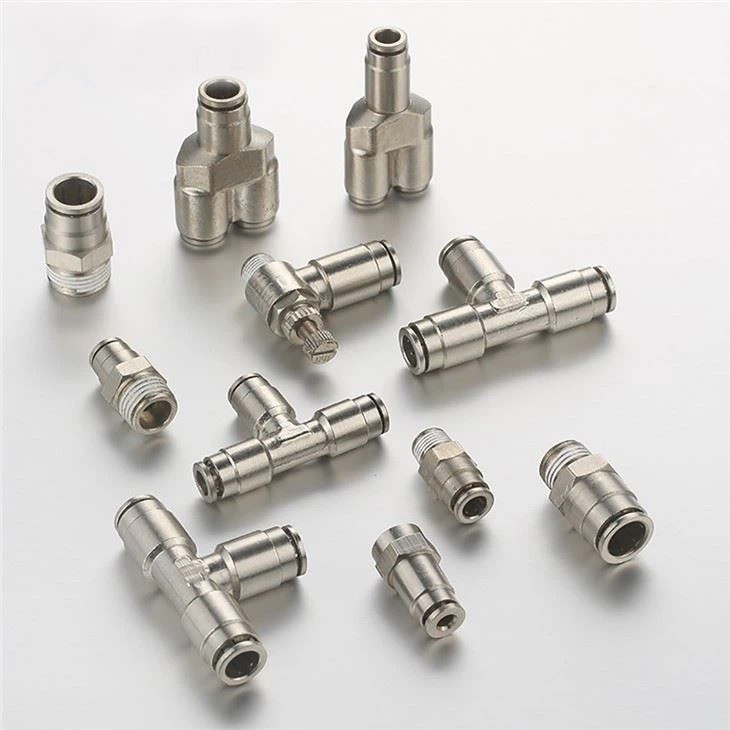When it comes to assembling and maintaining pneumatic systems, the importance of choosing the right fittings cannot be overstated. Pneumatic fittings are vital components that connect sections of pipes, tubes, and hoses in compressed air or gas systems used across various industries. From manufacturing plants to automotive repair shops, the efficiency and safety of pneumatic tools and systems largely depend on the fittings used. In this guide, we'll explore the factors to consider when selecting pneumatic fittings to ensure optimal performance and reliability.
Understanding Pneumatic Fittings
Pneumatic fittings come in various shapes, sizes, and materials, each suited to specific applications and pressure requirements. The most common materials include brass, stainless steel, and plastics like polyethylene and nylon. Brass fittings are renowned for their durability and corrosion resistance, making them suitable for a wide range of environments. Stainless steel fittings offer superior strength and are ideal for applications requiring hygiene, like the food and pharmaceutical industries. Plastic fittings are lightweight and economical, perfect for less demanding applications.
Several Types of Pneumatic Fittings
The selection of pneumatic fittings also hinges on the type of connection required. Some common types include:
- Push-to-Connect Fittings
Renowned for their user-friendly design, push-to-connect fittings are a staple in many pneumatic systems for their swift and tool-free assembly. The simplicity of their mechanism allows for rapid changes and maintenance, significantly reducing downtime in various industrial applications.
- Threaded Fittings
Threaded fittings are the bedrock of pneumatic connections, providing robust and reliable seals. Available in multiple standards such as NPT, these fittings are versatile and can be used in a wide array of configurations, making them suitable for a vast range of pressures and temperatures.
- Barbed Fittings
Barbed fittings offer an economical and efficient method for connecting flexible tubing. Their rigid design ensures a firm hold when paired with a clamp, providing a secure connection that is ideal for low-pressure applications and is easily assembled without specialized tools.
- Compression Fittings
For systems where high-pressure performance is paramount, compression fittings are the go-to choice. They work by compressing a ferrule onto a tube, creating a tight seal that is capable of withstanding high-pressure demands, ensuring safety and reliability in critical applications.
Factors to Consider
When selecting pneumatic fittings, several factors should be considered:
- Pressure Rating: It's imperative to choose a fitting that can handle the specific pressure levels of your system to prevent leaks or bursts that could lead to system failure or safety hazards.
- Size and Tubing Compatibility: The fitting must be compatible with the tubing or hose dimensions to ensure a snug fit, as mismatches can lead to inefficient operation or damage to the system components.
- Temperature Range: The materials of the fitting should be selected based on their ability to perform within the operational temperature range, as extreme temperatures can affect the integrity of the fitting.
- Environment: Fittings should be resistant to the environment in which they'll be used, especially if they will be exposed to harsh chemicals or corrosive substances that could degrade the material.
- Certifications: To comply with industry regulations and maintain system integrity, it's essential to use fittings that have been certified to meet standard quality and safety criteria.
Custom Solutions for Unique Applications
Sometimes, off-the-shelf fittings might not meet the specific requirements of a project. In such cases, custom pneumatic fittings can be designed to fit unique applications, ensuring that even the most challenging pneumatic systems operate efficiently.
Maintenance and Replacement
Regular maintenance of pneumatic fittings is crucial for the longevity of the system. It's essential to inspect fittings regularly for signs of wear and tear and to replace them promptly to avoid leaks and system failures.
Selecting the right pneumatic fittings is a critical task that requires careful consideration of various technical aspects. By understanding the types of fittings available and the specific requirements of your pneumatic system, you can ensure a reliable and safe operation. Always consult with a pneumatic systems specialist if you're uncertain about the best fitting for your application.
For Canadian businesses and industries, having a trusted supplier that understands local standards and offers a wide range of high-quality pneumatic fittings is invaluable. With the right selection, your pneumatic systems will function seamlessly, contributing to the overall productivity and efficiency of your operations



